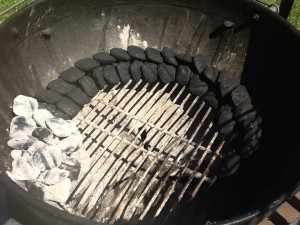Until recently, I have only used my 22.5 weber kettle (charcoal)for grilling and I love it. Now since being here and elsewhere I have discovered way more this thing can do, but I need to regulate the temp. I have been experimenting some with very little success. The other night I grilled some steaks (sort of) I set up for indirect heat, seared steaks directly over coals, then moved to cool side for some indirect love. At this point I began cutting back the intake vents and monitoring temps thru the exhaust vents with a Taylor 1470N digital. Every time I checked the steaks I readjusted and checked more. I never did really get any real regulation until the end when the intake was closed to maybe a 1/4 inch gap at the top of the hole and the temp was about 375F. (at about 410 the taylor loses it's mind). That leaves a very small range of movement to choke the kettle down to 225 upwards to 375.
It occured to me that as longs as the intake is bigger than the exhaust, it will run unregulated to the limits of the exhaust. I know from reading here and other places that I really don't want to cut back the exhaust except for possibly very fine adjustments.
I summize from some of the post here that many of you are engineering minded. Lend me some brain power. My thinking and math approximates that if I block off 2 of the 3 intake ports, the remaining port is just slightly larger than the combined 4 exhaust ports, thereby leaving me nearly the entire range of intake vent for heat control.
Am I barking up the wrong tree ? If not, which to leave open ? under the meat side ? under the coals ? Foil baffle under meat to direct flow to coals ect. Of course I do intend to keep exhaust vents over meat opposite coals.
Thanks for any input.
It occured to me that as longs as the intake is bigger than the exhaust, it will run unregulated to the limits of the exhaust. I know from reading here and other places that I really don't want to cut back the exhaust except for possibly very fine adjustments.
I summize from some of the post here that many of you are engineering minded. Lend me some brain power. My thinking and math approximates that if I block off 2 of the 3 intake ports, the remaining port is just slightly larger than the combined 4 exhaust ports, thereby leaving me nearly the entire range of intake vent for heat control.
Am I barking up the wrong tree ? If not, which to leave open ? under the meat side ? under the coals ? Foil baffle under meat to direct flow to coals ect. Of course I do intend to keep exhaust vents over meat opposite coals.
Thanks for any input.





